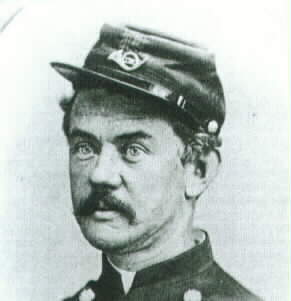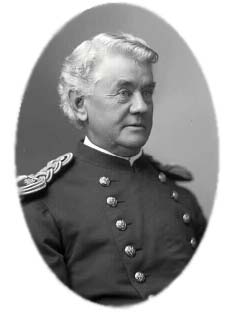Frederick Benteen facts for kids
Quick facts for kids
Frederick William Benteen
|
|
|---|---|

Frederick Benteen circa 1865
|
|
| Born | August 24, 1834 Petersburg, Virginia |
| Died | June 22, 1898 (aged 63) Atlanta, Georgia |
| Place of burial |
initially Atlanta, Georgia
reinterred in Arlington National Cemetery |
| Allegiance | Union |
| Service/ |
United States Army Union Army |
| Years of service | 1861–1888 |
| Rank | |
| Commands held | 10th Missouri Cavalry 138th U.S. Colored Infantry 'H' Company, 7th U.S. Cavalry |
| Battles/wars | |
Frederick William Benteen (born August 24, 1834 – died June 22, 1898) was an important military officer. He first served during the American Civil War. Later, he led troops in the Indian Wars and the Great Sioux War. These conflicts were against Native American groups like the Lakota and Northern Cheyenne.
Benteen is most famous for leading a group of soldiers (called a battalion) from the 7th U. S. Cavalry. This happened at the Battle of the Little Bighorn in June 1876. During this battle, his commander, George Armstrong Custer, sent him a message. Custer ordered Benteen to bring ammunition quickly and join his attack.
Benteen did not follow Custer's order right away. This decision is one of the most debated parts of the battle. Custer and his soldiers were all killed. However, Benteen's actions might have saved another group of soldiers led by Major Marcus Reno.
After this famous battle, Benteen continued to serve in the U.S. Cavalry for 12 more years. He was promoted for his service. He retired in 1888 due to health issues. He lived for another decade, passing away at age 63.
Contents
Early Life and Military Start
Frederick Benteen was born on August 24, 1834, in Petersburg, Virginia. His parents were Theodore Charles Benteen and Caroline (Hargrove) Benteen. His family had come to America from the Netherlands in the 1700s. They settled in Baltimore, Maryland.
Frederick's family moved to St. Louis, Missouri in 1849. When Abraham Lincoln became U.S. President in 1860, the country was divided. Missouri was a slave state, but many people there supported the Union. Frederick's father strongly supported the Southern states.
However, Frederick joined the Union Army on September 1, 1861. He became a first lieutenant in the 1st Missouri Volunteer Cavalry Regiment. This unit was later called the 10th Missouri Cavalry.
Benteen fought in many battles during the American Civil War. He earned special honors called brevet ranks, becoming a major and then a lieutenant colonel. Some of the battles he fought in were Wilson's Creek, Pea Ridge, Vicksburg, and Westport.
In February 1864, Benteen was promoted to lieutenant colonel. He took command of the 10th Missouri Cavalry. He left the army when the war ended in June 1865.
Soon after, he became a colonel leading the 138th Regiment Infantry U.S. Colored Troops. He led this group until January 1866. Later that year, he became a captain in the 7th U.S. Cavalry. He also received more brevet ranks for his bravery in battles like Battle of Mine Creek and Battle of Columbus (1865).
Serving with the 7th Cavalry under Custer
In January 1867, Captain Benteen joined the 7th US Cavalry Regiment. Its field commander was Lt. Col. George Armstrong Custer. Benteen served with this regiment for 16 years. During this time, he fought in many of the Indian Wars. He commanded H Troop of the 7th US Cavalry until 1882.
Benteen met Custer and his wife Elizabeth in January 1867. Benteen later said he thought Custer was boastful from their first meeting. His dislike for Custer grew over the years.
In March 1867, Benteen's wife gave birth to their son in Atlanta.
After the Civil War, the Cheyenne Indians were a big concern on the Kansas frontier. In July 1868, Benteen led a group to protect Indian agents near Fort Larned. In August, Benteen and 30 soldiers met a Cheyenne raiding party. He charged into what seemed like 50 warriors. Then he found more than 200 Cheyenne raiding a ranch. Benteen chased them all day. This was the first clear victory for the 7th US Cavalry. It earned Benteen another brevet to colonel.
In October, Benteen and his men were protecting a wagon train. It carried weapons and ammunition for the regiment. They arrived just as a war party attacked. Benteen drove off the attackers, saving the supplies. The 7th US Cavalry then followed the trail of the raiders. They found a Cheyenne camp on the Washita River in the Indian Territory.
General Philip Sheridan decided to punish the Cheyenne for their raids. His plan was to attack their winter camps. They would destroy supplies and livestock and kill those who fought back. This mission was very difficult. Sheridan chose Lt. Col. George Armstrong Custer to lead it. Custer returned to his regiment in November 1868 for this special mission.
On November 23, 1868, Custer left Camp Supply with 11 companies of the 7th US Cavalry. They headed towards the Washita River. On November 27, the 7th Cavalry surrounded a Cheyenne camp. Just before dawn, Custer launched a four-part attack. This was known as the Battle of Washita River.
As captain of H Troop, Benteen led a group during the attack. His horse was shot from under him by a son of Cheyenne Chief Black Kettle.
Custer's report about the battle did not say much about American soldier deaths. During the fight, the 7th lost only one man killed and seven wounded. However, after the battle, Major Joel Elliott and 19 men had chased warriors up the river. They did not return. It was later found that Elliott and all his men had been surrounded and killed by the Cheyenne.
Benteen believed Custer had left Elliott behind. He wrote a letter to a friend criticizing Custer. The letter was published in a newspaper without Benteen's permission. Custer was very angry and threatened to punish the writer. Benteen admitted he wrote the letter, but Custer did not act on his threat.
The Battle of Little Bighorn
In 1876, Captain Benteen was still leading H Troop of the Seventh US Cavalry. They were on an expedition to find the Lakota and Cheyenne. The goal was to make them move to reservations. On June 25, 1876, near the Little Bighorn River, Custer divided his soldiers into three groups.
Benteen was given command of a group of three companies (D, H, and K). His job was to search the left side of the area. He also had to make sure there were no escape routes. Benteen searched for about two hours but found nothing. He then returned to the main trail.
At a marshy spot called "the morass," he stopped for 20 minutes to let the horses drink. Some officers were worried about the delay. They heard gunfire in the distance. Captain Thomas Weir rode forward, saying Custer's companies "ought to be over there." Benteen ordered his group to follow.
As they got closer to the Little Bighorn River, two messengers from Custer met Benteen. They said a large village had been found and Benteen should come quickly. A note read: "Come on. Big village. Be quick. Bring packs." The slow pack mules, carrying extra ammunition, were still far behind. Benteen decided to move on without waiting for them.
Meanwhile, another group of soldiers led by Major Marcus Reno had attacked the large village. They were quickly pushed back with many losses. The remaining soldiers struggled to cross the river and climb a hill. Many warriors chased them. Benteen met Reno's exhausted soldiers on Reno Hill. Reno called out, "For God's sake Benteen! Halt your command and help me! I've lost half my men!"
Soon after, the chasing warriors turned away from them and headed north. Captain Thomas Mower McDougall, who was with the pack train, heard gunfire. The soldiers with Benteen and Reno also heard it. However, both Reno and Benteen later said they did not hear it. They did not immediately advance to find out what was happening. This later led to accusations that they had abandoned Custer.
After waiting for orders, Captain Weir rode north toward the sound of gunfire. He reached a spot now called Weir Point. From there, he saw a cloud of dust and smoke about three miles further north. They thought it was Custer. But then they saw many warriors coming from the smoke, heading toward them.
Just then, Benteen arrived. He realized this was not a good place to fight. He decided they must go back to their original position. This spot is now called the "Reno-Benteen defense site." Here, Benteen quickly set up a horseshoe-shaped defense on the hills. They were attacked right away and throughout the rest of the day.
As night came, the attacks slowed down. The large Lakota village was celebrating. Around 2:30 a.m., the attacks started again. Benteen took charge, leading charges that pushed the Native Americans back. He remained calm and encouraged his troops. He was wounded in the thumb, and his boot heel was shot off.
Attacks on the soldiers decreased by the afternoon of June 26. By 4:00 p.m., the gunfire stopped. By 5:00 p.m., thick smoke covered the village. The smoke cleared by sunset, showing the entire village moving away. It was moving south. Overnight, more soldiers from Reno's group, who were thought to be dead, rejoined them. Finally, on the morning of June 27, they saw a cloud of dust downriver. It was Generals Alfred Terry and John Gibbon. The battle was over.
When General Terry reached him, Benteen asked if he knew where Custer had gone. Terry replied that Custer and all his men were likely dead on a ridge about four miles away. Benteen could not believe it. Later, they rode to the battlefield. Benteen identified Custer's body.
After the battle, some people criticized Benteen. They questioned his decision to stay with Reno instead of going to help Custer right away. Benteen explained that he thought it was impossible to follow Custer's order. He said the Native Americans were fighting for their homes and families.
Later Military Service
Benteen also took part in the Nez Perce campaign in 1877. He was given the honorary rank of brigadier general in 1890. This was for his actions in that campaign at the Battle of Canyon Creek, and for his bravery at the Little Bighorn. He gave his testimony at the Reno Court of Inquiry in 1879 in Chicago.
Benteen was promoted to major in the 9th U.S. Cavalry in December 1882. He retired on July 7, 1888. He retired because of health problems like rheumatism and heart disease.
Family Life
In 1856, while stationed in Missouri, Benteen met Catharine "Kate" Louisa Norman. They married on January 7, 1862, in St. Louis. They had five children. Four of them sadly died when they were very young.
Their fourth child, Frederick Wilson, was born on March 27, 1873, in Atlanta, Georgia. He survived and lived until July 20, 1956. Like his father, he also had a military career and became a lieutenant colonel.
Death and Lasting Impact
Frederick Benteen passed away in Atlanta, Georgia, on June 22, 1898. He left behind his wife Kate and his son Frederick. He was buried in Westview Cemetery in Atlanta. Later, his remains were moved and re-buried at Arlington National Cemetery.
Benteen Elementary School in Atlanta, Georgia, is named after his son, Frederick Wilson Benteen. His son grew up in Atlanta and also had a military career.
Images for kids




